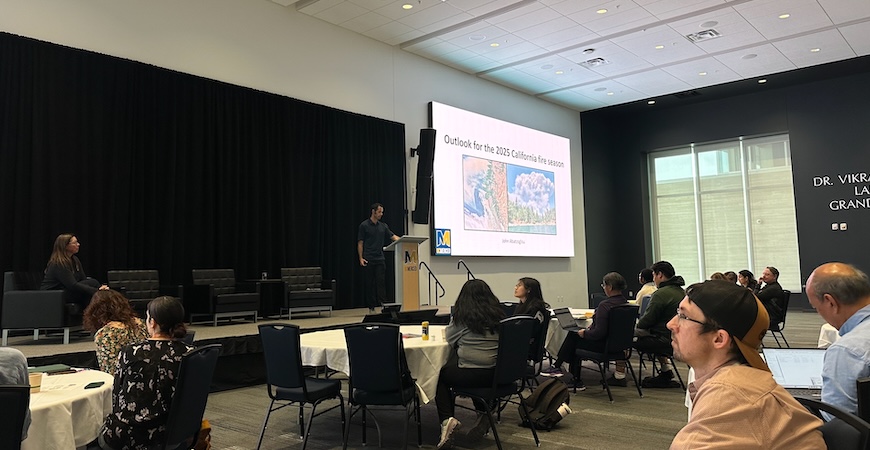
Pictures accompanying Professor John Abatzoglou's presentation on the 2025 fire season were blurry. That was intentional, he said, because so much about wildfire is unpredictable.
"There's a lot that we know, and a lot we don't know," he said.
However, Abatzoglou said, some conclusions can be drawn and measures taken to prepare. The management of complex systems professor spoke at a Fire Resilience Seminar hosted by UC Merced on April 17. UC Merced researchers Crystal Kolden and Sandie Ha and the founder of disaster information app Watch Duty, John Mills, also took part.
California has seen a significant increase in wildfires in the last 50 years, Abatzoglou said. "The last decade or so, it's been a bit of a roller coaster." The 2022 and 2023 seasons, for example, were relatively quiet.
Hotter, drier weather, which the Western United States has increasingly seen in the summer months, can exacerbate conditions. And wetter months ahead of those dry, hot days can provide more fuel for fires.
A short series of hot days can change conditions quickly.
"Heat waves are another key ingredient for catalyzing fire," Abatzoglou said. "Half of the burned area in California happened either during or in the three days after a heat event."
This year, a fairly wet winter in northern California will likely slightly delay the start of fire season. Southern California remains in drought conditions, but had a wetter-than-normal March, which might also stave off fires for a while.
"We're probably not going to see anything really interesting right now or over the next few months, but come summer, if we don't get any significant rain events…things could be on," Abatzoglou said.

Other factors include winds and lightning - which caused destructive fires in August 2020 - and human behavior. According to the National Parks Service, nearly 85 percent of wildland fires in the United States are caused by humans, including campfires left unattended, the burning of debris, equipment use and malfunction, discarded cigarettes and arson.
All those fires impact the health of the people around them, and of Central Valley residents because fire-polluted air settles between mountain ranges and can be slow to move.
Ha, a public health professor and member of the Health Sciences Research Institute, outlined the health risks associated with wildfires and what measures can be taken to mitigate them.
"As we know, the composition of the air pollution emitted by wildfire can be slightly different from regular ambient air pollution we are regularly exposed to," she said. This pollution has more toxic components, such as ultrafine particles and metals.
Wildfire pollution impacts just about every system in the body, Ha said, including cardiovascular, respiratory and reproductive. Perhaps less immediately obvious is the toll fires take on mental health.
Wildfire exposure is linked to a higher risk of mental health complications due to the stress of uncertainty about one's home, pets or loved ones. This often manifests in post-traumatic stress disorder, sleep disturbance, anger, interpersonal violence and depression, Ha said.
"Mental health complications can exacerbate the physical health impacts that people maybe already have as well."
People can counteract these impacts by remaining informed and implementing measures such as air purifiers and closed windows when the conditions are bad outside.
But the responsibility isn't just on individuals, the researchers said.
Health care providers can help by training and educating patients, paying special attention to early warning signs about mental and physical health complications, and by collaborating with public health and local agencies.
Researchers are working to identify health impacts and mechanisms, identify people at risk and develop and test novel tools to mitigate risks.
Policymakers can help by establishing early warning systems and equitable policies to reduce wildfire risks, and earmarking funding for more research and services.
The lack of sufficient early warning systems led Mills to create the Watch Duty app. Mills, an entrepreneur, started the disaster information app after moving to Sonoma and experiencing devastating wildfire firsthand. The only notice he got about a nearby fire was seeing a helicopter carrying water above his house, he said.
Mills did some research and learned no instrument existed for communicating vital information about disasters in real time to people who might be in harm's way, or even among first response agencies.
"Firefighters put their lives on the line for us," he said. "They don't have what they need."
He put together a network of volunteers and formed a nonprofit organization that aggregates and vets information on fires as they break out and shares it with users. The app has been so successful that he has launched a premium version for firefighters and the government and is looking to expand its use throughout the United States and beyond.
"Watch Duty was made for two groups of people - people who run toward the fire and people who run away from it," Mills said. "So, everybody."
The information Watch Duty provides is vital, said Kolden, a management of complex systems professor and director of UC Merced's Fire Resilience Center.
"In talking with people who ran for their lives in the 2017 fires, in the 2018 Camp fire, we hear over and over again how they didn't know what to do," she said. "The lack of information was a big piece of how we had such destruction."
In the last decade, California alone has seen more than 300 civilian fatalities, more than 50,000 homes destroyed by wildfires, and millions of people evacuated for days, weeks or even months at time, Kolden said.
The Fire Resilience Center, started last year under the Climate Institute of the university's Sierra Nevada Research Institute with funding from the Packard Foundation, aims to support wildfire solutions that benefit all Californians, Kolden said.
"I hope this seminar will be the first of future special events as we work toward how we become more resilient and better live with wildfire in California and across the United States."




 Public Information Officer
Public Information Officer

